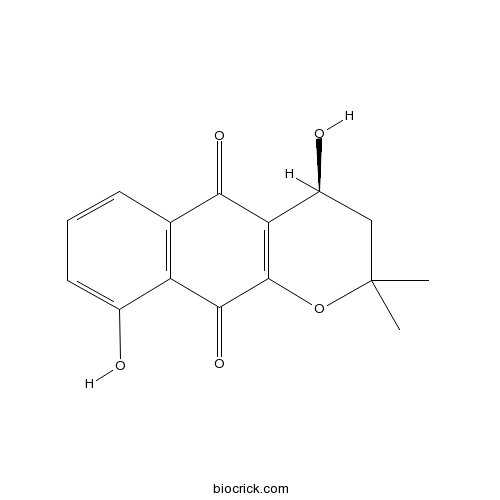4,9-Dihydroxy-alpha-lapachoneCAS# 56473-67-7 |

Quality Control & MSDS
3D structure
Package In Stock
Number of papers citing our products

| Cas No. | 56473-67-7 | SDF | Download SDF |
| PubChem ID | 44575422 | Appearance | Yellow powder |
| Formula | C15H14O5 | M.Wt | 274.3 |
| Type of Compound | Quinones | Storage | Desiccate at -20°C |
| Solubility | Soluble in Chloroform,Dichloromethane,Ethyl Acetate,DMSO,Acetone,etc. | ||
| Chemical Name | (4S)-4,9-dihydroxy-2,2-dimethyl-3,4-dihydrobenzo[g]chromene-5,10-dione | ||
| SMILES | CC1(CC(C2=C(O1)C(=O)C3=C(C2=O)C=CC=C3O)O)C | ||
| Standard InChIKey | KGIQEUTUJPXAKQ-VIFPVBQESA-N | ||
| General tips | For obtaining a higher solubility , please warm the tube at 37 ℃ and shake it in the ultrasonic bath for a while.Stock solution can be stored below -20℃ for several months. We recommend that you prepare and use the solution on the same day. However, if the test schedule requires, the stock solutions can be prepared in advance, and the stock solution must be sealed and stored below -20℃. In general, the stock solution can be kept for several months. Before use, we recommend that you leave the vial at room temperature for at least an hour before opening it. |
||
| About Packaging | 1. The packaging of the product may be reversed during transportation, cause the high purity compounds to adhere to the neck or cap of the vial.Take the vail out of its packaging and shake gently until the compounds fall to the bottom of the vial. 2. For liquid products, please centrifuge at 500xg to gather the liquid to the bottom of the vial. 3. Try to avoid loss or contamination during the experiment. |
||
| Shipping Condition | Packaging according to customer requirements(5mg, 10mg, 20mg and more). Ship via FedEx, DHL, UPS, EMS or other couriers with RT, or blue ice upon request. | ||
| Description | 1. 4,9-Dihydroxy-alpha-lapachone has antitumor-promoting effects, it exhibits significant inhibitory activity against 12-O-tetradecanoylphorbol 13-acetate (TPA)-induced Epstein-Barr virus early antigen (EBV-EA) activation in Raji cells. 2. 4,9-Dihydroxy-alpha-lapachone exhibits potent inhibitory effects on lipopolysaccharide-induced NO synthesis in RAW 264.7 cells , with IC(50) value of 2.73 microM. |
| Targets | NO |

4,9-Dihydroxy-alpha-lapachone Dilution Calculator

4,9-Dihydroxy-alpha-lapachone Molarity Calculator
| 1 mg | 5 mg | 10 mg | 20 mg | 25 mg | |
| 1 mM | 3.6456 mL | 18.2282 mL | 36.4564 mL | 72.9129 mL | 91.1411 mL |
| 5 mM | 0.7291 mL | 3.6456 mL | 7.2913 mL | 14.5826 mL | 18.2282 mL |
| 10 mM | 0.3646 mL | 1.8228 mL | 3.6456 mL | 7.2913 mL | 9.1141 mL |
| 50 mM | 0.0729 mL | 0.3646 mL | 0.7291 mL | 1.4583 mL | 1.8228 mL |
| 100 mM | 0.0365 mL | 0.1823 mL | 0.3646 mL | 0.7291 mL | 0.9114 mL |
| * Note: If you are in the process of experiment, it's necessary to make the dilution ratios of the samples. The dilution data above is only for reference. Normally, it's can get a better solubility within lower of Concentrations. | |||||

Calcutta University

University of Minnesota

University of Maryland School of Medicine

University of Illinois at Chicago

The Ohio State University

University of Zurich

Harvard University

Colorado State University

Auburn University

Yale University

Worcester Polytechnic Institute

Washington State University

Stanford University

University of Leipzig

Universidade da Beira Interior

The Institute of Cancer Research

Heidelberg University

University of Amsterdam

University of Auckland

TsingHua University

The University of Michigan

Miami University

DRURY University

Jilin University

Fudan University

Wuhan University

Sun Yat-sen University

Universite de Paris

Deemed University

Auckland University

The University of Tokyo

Korea University
- Eichlerianic acid
Catalog No.:BCN5757
CAS No.:56421-13-7
- Methyl eichlerianate
Catalog No.:BCN5756
CAS No.:56421-12-6
- Tetrahydrolachnophyllum lactone
Catalog No.:BCN4759
CAS No.:56407-87-5
- Hinokiol
Catalog No.:BCN5759
CAS No.:564-73-8
- 11α-Hydroxyandrost-4-ene-3,17-dione
Catalog No.:BCC8432
CAS No.:564-33-0
- Doxycycline
Catalog No.:BCN2397
CAS No.:564-25-0
- Sclareolide
Catalog No.:BCC6492
CAS No.:564-20-5
- Hop-17(21)-en-3-ol
Catalog No.:BCN5755
CAS No.:564-14-7
- UK-5099
Catalog No.:BCC2021
CAS No.:56396-35-1
- Metoprolol Tartrate
Catalog No.:BCC4330
CAS No.:56392-17-7
- Netilmicin Sulfate
Catalog No.:BCC4683
CAS No.:56391-57-2
- Epirubicin HCl
Catalog No.:BCC1192
CAS No.:56390-09-1
- Steppogenin
Catalog No.:BCN5760
CAS No.:56486-94-3
- Angelic acid
Catalog No.:BCN3410
CAS No.:565-63-9
- 2-Hydroxy-3,4-dimethoxybenzoic acid
Catalog No.:BCN6535
CAS No.:5653-46-3
- Cyclo(Tyr-Pro)
Catalog No.:BCN2421
CAS No.:5654-84-2
- Cyclo(Pro-Leu)
Catalog No.:BCN2426
CAS No.:5654-86-4
- Cyclo(Pro-Val)
Catalog No.:BCN2420
CAS No.:5654-87-5
- (-)-Bornyl acetate
Catalog No.:BCN2636
CAS No.:5655-61-8
- PIT
Catalog No.:BCC7151
CAS No.:56583-49-4
- 3-Hydroxy-2-phenyl-propanamide
Catalog No.:BCN3905
CAS No.:56598-62-0
- 7-Keto-dehydroepiandrosterone
Catalog No.:BCC8780
CAS No.:566-19-8
- 7Beta-Hydroxycholesterol
Catalog No.:BCN2751
CAS No.:566-27-8
- Formestane
Catalog No.:BCC4369
CAS No.:566-48-3
Antitumor-promoting naphthoquinones from Catalpa ovata.[Pubmed:9599262]
J Nat Prod. 1998 May;61(5):629-32.
Bioassay-directed fractionation of an extract of the stem-bark of Catalpa ovata led to the isolation of three new naphthoquinones: 8-methoxydehydroiso-alpha-lapachone (1), 9-methoxy-4-oxo-alpha-lapachone (2), and (4S,4aR,10R,10aR)-4, 10-dihydroxy-2,2-dimethyl-2,3,4,4alpha,10, 10alpha-hexahydrobenzo[g]chromen-5-one (3), which is a 1,4-reductive form of 6. The known compounds 3-hydroxydehydroiso-alpha-lapachone (4), 4,9-Dihydroxy-alpha-lapachone (5), 4-hydroxy-alpha-lapachone (6), and 9-methoxy-alpha-lapachone (7), and catalpalactone (8) were also isolated. Their structures were elucidated by spectral methods. These compounds all exhibited significant inhibitory activity against 12-O-tetradecanoylphorbol 13-acetate (TPA)-induced Epstein-Barr virus early antigen (EBV-EA) activation in Raji cells.
Naphthoquinones from Catalpa ovata and their inhibitory effects on the production of nitric oxide.[Pubmed:20361302]
Arch Pharm Res. 2010 Mar;33(3):381-5.
Bioassay-guided fractionation of a CH2Cl2-soluble fraction of the stems of Catalpa ovata led to isolation of a new naphthoquinone, 4-hydroxy-2-(2-methoxy-3-hydroxy-3-methyl-but-1-enyl)-4-hydro-1H-naphthalen-1-one (10), together with nine known compounds, catalponol (1), catalponone (2), catalpalactone (3), alpha-lapachone (4), 9-hydroxy-alpha-lapachone (5), 4,9-Dihydroxy-alpha-lapachone (6), 9-methoxy-alpha-lapachone (7), 4-oxo-alpha-lapachone (8), and 9-methoxy-4-oxo-alpha-lapachone (9). The structures were elucidated on the basis of spectroscopic analyses. The inhibitory effects of these isolates on lipopolysaccharide-induced NO synthesis in RAW 264.7 cells were evaluated. Among them, catapalactone (3), 9-hydroxy-alpha-lapachone (5) and 4,9-Dihydroxy-alpha-lapachone (6) exhibited potent inhibitory effects, with IC(50) values of 9.80, 4.64 and 2.73 microM, respectively.


